How to use Planning Poker to improve your sprint planning meetings
Learn how to use Planning Poker to improve your sprint planning meetings and deliver more value to your customers.

What is Planning Poker?
Planning Poker is a consensus-based technique for estimating effort in agile software development. It is a fun and engaging way for teams to apply relative estimates to planned work. Planning Poker can be used to improve sprint planning meetings in a number of ways:
- It helps to reduce bias and groupthink. In traditional estimation techniques, the loudest or most influential team members may tend to dominate the discussion and influence the estimates. Planning Poker helps to level the playing field by giving everyone an equal voice.
- It encourages collaboration and communication. Planning Poker is a team exercise that requires everyone to participate and share their thoughts. This helps to foster collaboration and communication within the team.
- It leads to more realistic estimates. Planning Poker estimates are based on the collective knowledge and experience of the team. This makes them more likely to be realistic and achievable than estimates that are made by individuals.
How to use Planning Poker in your sprint planning meeting
- Prepare. Make sure that everyone on the team has a deck of Planning Poker cards. You can use physical cards or an online tool such as PlanningPoker.live. Using an online tool is a good idea, since it automatically tracks estimates, history and calculates statistics.
- Read the user story. The Product Owner reads the user story aloud to the team and sets the topic in the app.
- Estimate. Each team member selects a card from their deck that represents their estimate of the effort required to complete the user story.
- Reveal. Everyone reveals their cards at the same time. When played online, this step is done by the leader of the meeting.
- Discuss. If the estimates are widely different, the team discusses the reasons for the differences and tries to reach a consensus.
- Repeat. Steps 3-5 are repeated until the team reaches a consensus on an estimate for the user story.
Tips for using Planning Poker effectively
- Use a Fibonacci sequence. Planning Poker cards are typically numbered in a Fibonacci sequence, such as 0, 1, 2, 3, 5, 8, 13, 21, 34, 55, and 89. This sequence helps to avoid the tendency to estimate in whole numbers. You can learn more about different estimation techniques in our comparison guide.
- Use relative estimates. Planning Poker estimates are relative to each other, rather than to a specific unit of time. This helps to avoid the problem of overestimating or underestimating complex tasks.
- Don't be afraid to say "I don't know." If you don't have enough information to estimate a user story, it's okay to say so. The goal of Planning Poker is to get a rough estimate of the effort required, not to be precise. When played online, you can add a "Pass" card to the deck to represent this vote.
- Don't be afraid to change your mind. If you hear new information during the discussion phase, you can change your estimate. The goal is to reach a consensus on an estimate that everyone is comfortable with.
Additional tips
- Start with a small set of user stories. Don't try to estimate all of the user stories for the Sprint in one sitting. Start with a small set of user stories, and then come back to the rest later.
- Take breaks. Planning Poker can be mentally draining, so it's important to take breaks. Get up and move around, or do something else for a while.
- Keep a human connection. Use Planning Poker in real-life or during a video conference. You can install an extension of PlanningPoker.live in your favorite video conferencing tool to see each other during the session.
- Have fun! Planning Poker should be a fun and collaborative experience. Don't take it too seriously.
Planning Poker is a powerful tool that can help you to improve your sprint planning meetings and deliver more value to your customers. By following the tips above, you can use Planning Poker effectively to estimate the effort required for your Sprint Backlog items.
Learn more about how different Scrum roles can use Planning Poker effectively.
Planning PokerSprint PlanningAgile EstimationTeam CollaborationEstimation Techniques

